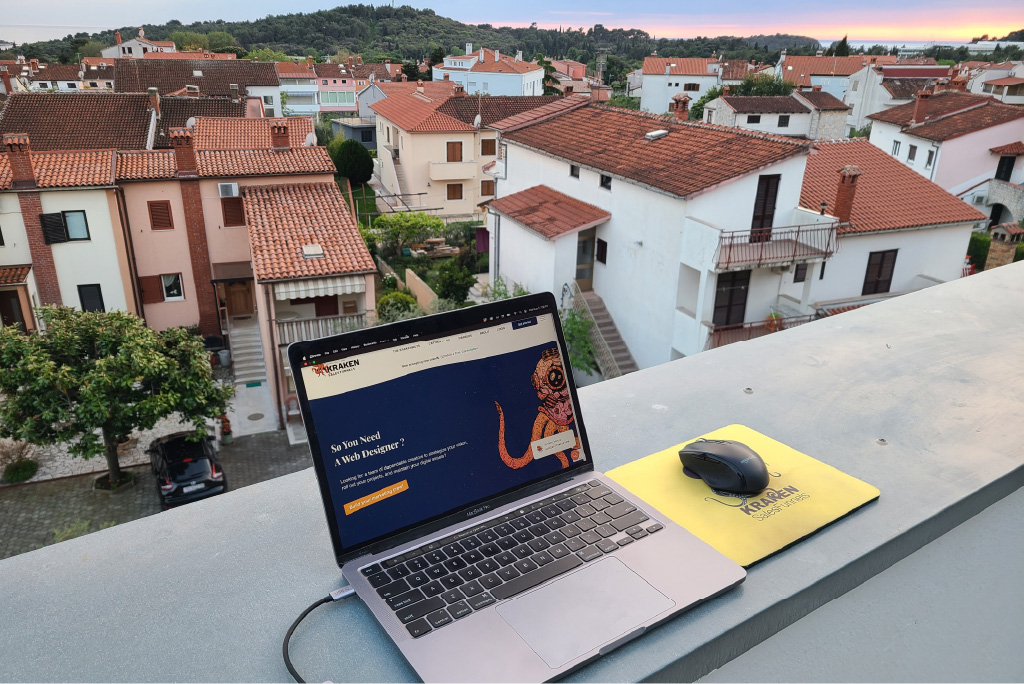Digital nomad life is the younger generation’s version of jet setting, the ultimate dream of working abroad in exotic locales, free from cubicles and hum-drum routines. But what was it like for me to work remotely from another country for the first time?
I’m no stranger to working remotely. I do it on a daily basis, and at times, I work “remotely remote” from other states while taking a workation.
I’m familiar with deciding whether to “go light” by bringing just my laptop and mouse or whether to fill a giant tote with my external monitor, external keyboard, laptop stand, monitor stand, and desk lamp in order to recreate my comfortable WFH (work from home) environment in an Airbnb, a motel room, or a friend’s guest room. I know what it’s like to study Airbnb photos to make sure there’s a decent chair and desk or table to work at without getting a neck cramp. And I always remember to bring my mousepad in case the surface I’m using my external mouse on is made out of glass.
But working from a couple countries halfway around the world takes #workingremotely up a notch.
To celebrate my upcoming 40th birthday, my wife and I took a budget trip to Slovenia and Croatia. We choose those countries based on friends’ recommendations, their incredible affordability compared to Western European hotspots, and the novelty of visiting a place most Americans had never heard of (Slovenia). Both countries far exceeded our expectations with their jaw-dropping beauty, ancient ruins, and wonderful hospitality.
I extended our trip to 2 ½ weeks, promising my boss that I’d check in each day on my laptop and be available during the day to answer questions from co-workers everywhere that I had cellphone reception. To ensure this was feasible, I did several essential things in preparation for the trip.

Purchased an international data plan for my phone
I bought a 30-day pass from T-Mobile that gave me plenty of data for our 17-day excursion. While we never got 5G speeds, we had surprisingly fast 4G almost everywhere we went. It also allowed us to use Google Maps’ voice navigation to get around and eliminated the need to stop random strangers to ask them how to get to places with names like Počivališče Ravbarkomanda that will make you pass out before you make it to the ninth syllable.
Made sure that each Airbnb had fast, reliable internet
In selecting the three Airbnbs for our trip, I carefully researched the host descriptions to see who listed their WiFi speed (an increasingly common trend with the increase in digital nomads). I also checked reviews, running word searches on “wifi,” “wi-fi,” and “internet” to see what other guests said about the connection. When needed, I messaged hosts directly through the Airbnb app to ask questions. Once we got to Slovenia and Croatia, we discovered that each Airbnb we had chosen delivered the bandwidth and reliability I needed.
Checked for comfortable work spaces
Even though I was only working up to an hour a day, I didn’t want to have to do so while sitting on a bed, especially if a work emergency necessitated that I work longer. We made sure each Airbnb, at minimum, had a chair and dining table. I also brought along an HDMI cable in case I wanted to use an available TV as an external monitor.
Blocked out travel days
With a day-and-a-half of travel to get from Idaho to Slovenia and a day-and-a-half to get back, I let my coworkers know my availability would be very limited those days. I didn’t purchase a WiFi pass for any of the airplanes, choosing instead to get as much rest as I could to proactively combat jet lag. Jet lag is the worst.
Installed two VPNs
I consider using a VPN essential when traveling, especially when connecting to public airport WiFi networks. For this trip, I decided to try a free trial of NordVPN and the always-free Proton VPN. Both worked well, only reducing my internet speed by a little bit. Having two VPNs was handy because occasionally one or the other would have trouble connecting.
Packed my laptop backpack as my personal item
I own a laptop backpack that’s small enough to fit under the airline seat in front of me while still being plenty roomy for my tiny MacBook Pro. This allowed me to always have my laptop within sight and within reach as we traveled through multiple airports. I didn’t want to put my laptop in my carry-on suitcase because it has a tendency to get gate checked on small, very full aircraft. Both Slovenia and Croatia felt very safe, though, and I had no concern about leaving my laptop in our locked Airbnb rooms when we were exploring during the daytime.

All of these preparations came in useful while checking in each evening after a day of hiking around the Alps, biking along the Adriatic Sea, exploring a medieval village, or marveling at 2,000-year-old Roman ruins. But one aspect of far-flung sojourning made itself frequently apparent: time zone differences.
Working remotely in Europe 6-to-9 hours ahead of most of my coworkers made the clock in my brain do painful contortions as I tried to figure out if I was messaging someone in the middle of their night or the middle of their workday. If I messaged someone at 8 a.m. my time, I might get an immediate response from a night owl or no response at all for the next 8 hours from someone who operated on normal business hours. Not being great at math, I often asked Google what time it was in Boise or Chicago or the Bay Area. (Note: My Google apps automatically adjusted to Central European Time as my VPN was connecting to nearby countries).

Working remote and traveling on a much longer trip
The drastic time zone difference wasn’t a huge issue since I wasn’t working much, but if I were to do an extended stay in Slovenia — for instance — I would need to make major adjustments to my full-time work schedule.
Rather than having evenings to roam free on weekdays, I’d probably need to work in the afternoons and evenings, leaving mornings as our time to scramble around castle ruins, partake in local cuisines, or paddleboard across crystal-clear lakes. Completing most of my job tasks outside the hours that coworkers and clients operate would make communication difficult, so I would need to adjust my expectations of weekday activities based on morning weather and operating hours.
Another thing to keep in mind with working remotely from another country full-time is the 90-day limit if you don’t have a work visa (depending on the country) and the fact that you still have to do normal, mundane tasks, like cooking, shopping, cleaning, and laundry. If you’re working at least eight hours a day, not every day will be spent having Instagram-worthy experiences in your free time.
Still, with plenty of research and planning, coordination with your team, and realistic expectations, your digital nomad experience abroad could be as awesome as you hoped for — and more — as you immerse yourself in a different culture, meet new people, and take photos that will make your trip last a lifetime.
(Note: This entire article was written remotely from a waiting room)



